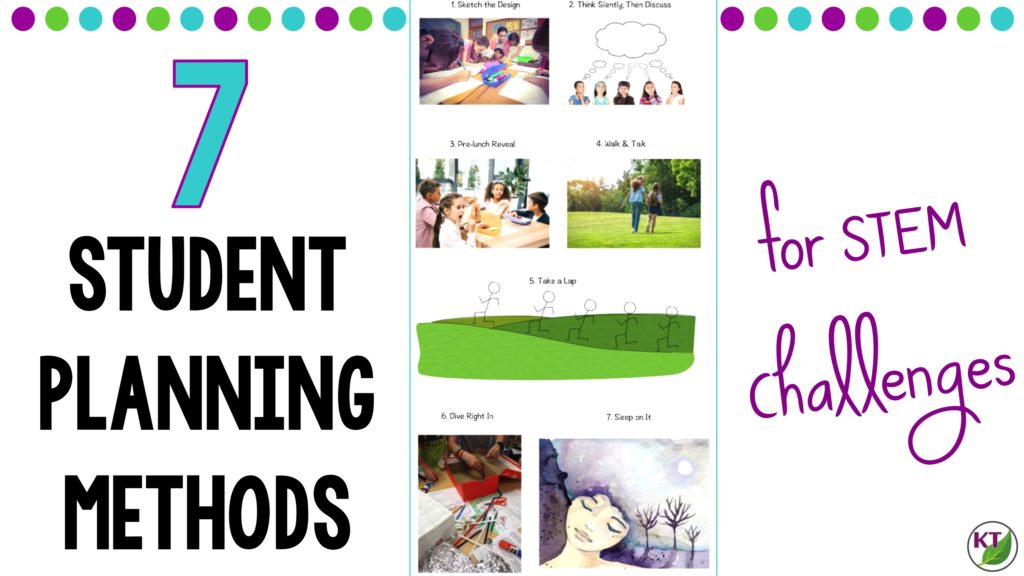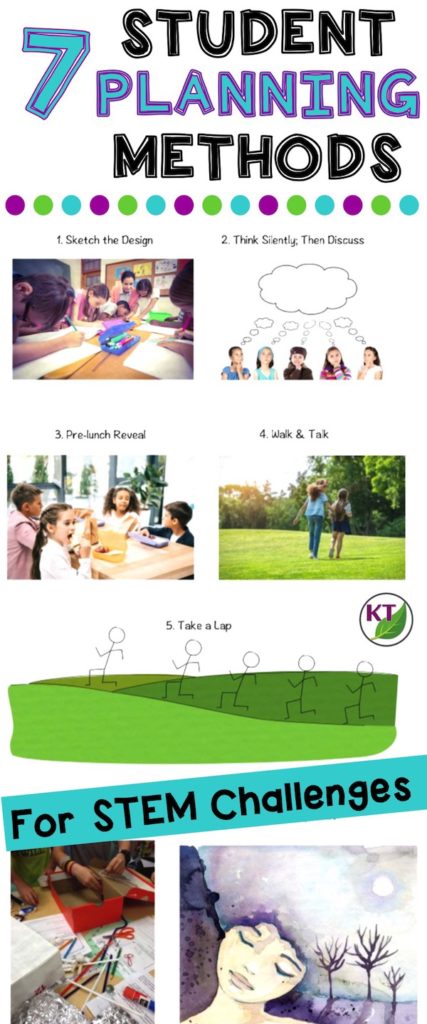It’s easy to get into a routine, and sometimes routines turn into ruts in our classrooms! Because our students have different learning styles, skills, and talents, we should try to honor that as often as possible in as many ways as possible. One area we can add to our repertoire is the planning step of the STEM Challenge Cycle. Three cheers for mixing it up and keeping it fresh!

As I mention in the video embedded below, the idea of creating a rotation of planning methods came from my own learning style. Most of them time, students are asked to sketch before they begin work. Being asked to draw something throws me into a mini panic attack; I just can’t ever seem to translate the vision in my head to paper. So when a teacher asks me to sketch my idea, I throw in all my avoidance techniques: move slowly, draw/erase/draw/erase, ride out the clock, ask to go to the bathroom, etc.!
Drawing, of course, is a great planning method. Plenty of students LOVE this method! But it isn’t the ONLY method. We can help students learn styles that work well for them by giving them experience with multiple planning methods.
Underneath the video below, you will find its transcription. You can watch and/or read about seven different ways to let students plan. Do you have a favorite way to let students plan? I’d love to hear it, so please let me know in the comments!
Watch Me!
Transcription
Hi! I’m Kerry from Feel-Good Teaching. Today we are talking about the planning phase of the STEM Challenge Cycle. So this is the time that you give students, once you’ve actually introduced the challenge explained what they’re supposed to do, you give the students five to 10 minutes to plan their designs. So this phase goes by so quickly that a lot of times we don’t give much thought to it and we can get stuck in sort of a rut. Most of the time what I see teachers doing is asking students to sketch out their designs before they start building. And that’s certainly a valid approach but it isn’t the only approach. And I’d like us to think about some other methods to use because we have multiple intelligences (and learning styles) in our classroom and this is coming from a personal bias. I don’t like to draw.
I’m not very good at it. And whatever I attempt to draw never really looks the way that I mean for it to. So for me as a student when my teacher tells me I have to sketch something out before I’m allowed to build it is an instant enthusiasm killer. I would never suggest throwing out sketching as a planning method. I’m just saying let’s make it part of a rotation and if I’m suggesting a rotation I better have some other planning methods to back up my idea. So today I want to share some other planning methods. You can fold into your rotation so students can get experience with different ways of planning and find something that suits them best.
1. Sketch the Design
This is a tried-and-true method and it’s by far the most used. For that reason, and because not all students are able to translate their ideas visually in 2D, try relying on this method a little less frequently and give other methods a chance to come up for air.
2. Think Silently; Then Discuss
Give students a minute or two of complete silence to simply think of their ideas. Then give them three to five minutes to discuss and settle on a plan within their groups. This gives all students time to come up with their own ideas. Occasionally when you jump right into a challenge, the loudest or first voice in the group wins the day. This method is especially beneficial for introverts who sometimes need the calm before the chaos begins to formulate their ideas and participate fully in their groups.
3. Pre-lunch Reveal
This is similar to the previous method, except students have more time to ponder ideas if they choose to use it. If you set up groups and materials before lunch as well, it allows you to get to work with no time wasted when students return from lunch.
4. Walk & Talk
Our minds work well when our bodies are in motion. Explain the challenge, show students the materials they will get to use, and then have them take a short walk with their partners or groups to discuss a plan. You can save time by introducing a challenge when students are already outside, like when you’re picking them up in the morning, after recess or lunch, or even PE.
5. Take a Lap
This idea combines the benefits of the body in motion with the benefits of having time and space to think on your own before having to discuss within a group setting. With this idea, don’t assign groups until after the lap is completed. Whether you ask students to run or walk is up to you. After the lap, return to class, form groups, and get started.
6. Dive Right In
This one is for the tactile learners. Some students plan best when they can manipulate the materials while they discuss and form their ideas. This method works better for individual or partner challenges than it does with group challenges. In groups, sometimes the dominant personality may use this method to steamroll other group members by quickly using materials like tape in a way that can’t be undone. This is a great method for your tactile learners and for those who have spatial awareness issues and can’t necessarily imagine how the materials will interact with each other until they put it into action.
7. Sleep on It
Have you ever thought of the perfect thing to say to someone just a day too late? That’s kind of what this method is all about. It’s another one for the introverts, the ponderers, the mullers, and those for whom time-based tasks arouse anxiety. Although a valid approach, I still use this one sparingly because some of my students in the past have used the time to research the science online or gotten ideas from their engineer parents. Since at least for the first iteration I want to see innovative, somewhat spontaneous, student-centered work, I try to limit research of any kind until we are preparing for the second iteration of a challenge. Still, some of my best ideas have come to me in a dream, so I like to keep this method in the rotation.
Those are just seven different options. They should be more than enough to get you started. What’s really nice is over time, students start to develop their own planning styles and they figure out what works well for them. Down the line, you could even let students self-select their groups based on planning styles that are complimentary to each other. We all know our students have different talents and gifts, so it’s nice to mix things up when we can.
If you have a planning approach you like to use in your classroom, I’d love to hear it and I’m sure others will too. Please share it in the comments below. Don’t forget to like and subscribe so you don’t miss anything. I hope you have a fabulous week packed with feel-good teaching moments. See you soon.
Pin Me!




